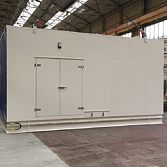Silencing Factories to Protect the Health of the Employees
A large number of industrial appliances and machinery make quite a bit of noise because of moving parts such as rotors, vibrating panels, gears, engines, fans, belts, and more. Noise has increasingly turned out to be a significant occupational hazard for any factory worker and has led to noise-induced hearing loss in many countries across the globe. Thus, factory noise control has become more important as the percentage of those exposed to such loud noise at work ranges from between 12%-15% amongst all employed persons.
Steps were taken to reduce noise in factories
Control technology has been developed in recent years to have some sort of factory noise control as a protective measure for the health of factory workers. Here are some steps that are being taken:
- Since it is not feasible to implement factory noise control globally all at once, some level of prioritization is necessary
- Evaluate the noise that is being produced in the industry – noise level, type, frequency, patterns, sources, power, pathways, and reverb – which provides a noise spectrum to subsequently helps set a goal for noise reduction and control
- Consider the number of employees complaining of any health issues caused due to the noise pollution at work and the type of problem that is most common to pinpoint what to repair or replace or modify first
- Alter some aspects of the three main elements of noise – source, transmitting path, receiver – to control the noise level. Here are some ways one can do that:
- Modify the machine or the source of the noise to reduce the amount of noise it makes
- Control the propagation path in a way that it muffles the sound before reaching the ear
- Make the worker wear some sort of protective gear to prevent the noise from entering their ear or one that muffles the noise while they work
Booths to protect workers from noise pollution
The best way to reduce overall noise pollution is to alter the source of the problem so that it makes less noise, but in many cases, this is not possible. In such situations, construction workers are called to factories to build booths called acoustic enclosures that isolate the employees exposed to the sound from the noisy area. Acoustic enclosures are soundproof control rooms that have a limited number of openings like doors and windows as they are weak spots of soundproofing. Ventilation systems are designed in such a way that they are sealed to prevent the leakage of sound.
One of the main disadvantages of the acoustic enclosure is that any work that cannot complete its tasks remotely cannot avail of its benefits. In such cases, they wear noise-canceling gear to prevent their ears from being affected by the loudness of the noise of the machines they’re working with.
Acoustic booths are made of thick noise absorbing material and steel panels for the minimization, reduction, attenuation, or cancellation of generated noise. Good quality enclosures are long-term investments for dampening vibrations and sound. There are two types of acoustic enclosures:
- Integrated Enclosure: These booths reduce the noise generated by around 35 dB and have good quality ventilation and air conditioning. They often come equipped with sliding doors that reduce the amount of sound leakage.
- Partial Acoustic Enclosure: These booths have motorized doors that are customized to fit the shape of the machinery but have a partial ceiling. It often includes a silencer that allows for ventilation.
The construction of more of these booths is being implemented to protect and maintain the health of all factory workers.
Reactions
Be the first to write a review.
In an airport, noise control is principal. To secure the immediate environment from noise from aircraft engines' routine testing, a Ground Run-up Enclosure (GRE) is utilized to decrease the noise leve
Read more
20-09-2020 - A Simple Guide On Soundproofing A Studio Recording Room
Suppose you never visit any studio recording room. In that case, we will never realize how noisy the world is… all world noises that we never noticed may become painful when heard through a ver
Read more
Author
Jenny ClarkeJenny Clarke is a professional writer who writes for varieties of online publications. Her interests of writing are home improvement ideas, home decoration, modern furniture, noise cancellation and a lot more.

